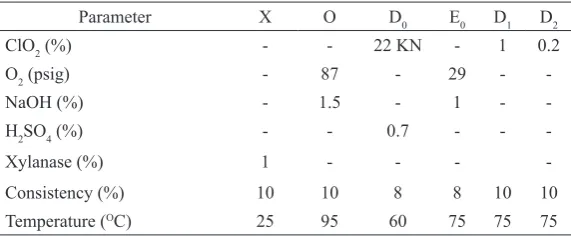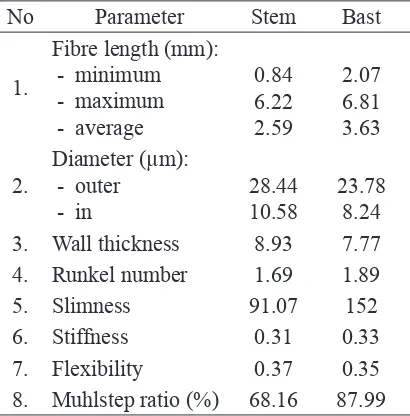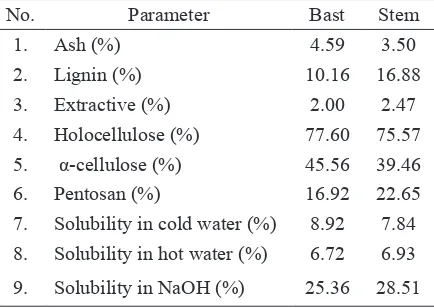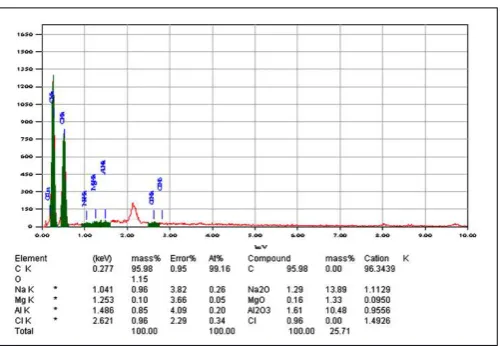DISSOLVING PULP FROM KENAF BY BIO-BLEACHING PROCESS
Susi Sugesty 1, Yusup Setiawan Centre for Pulp and Paper (CPP)
Jl. Raya Dayeuhkolot No. 132, Bandung-Indonesia
Diterima : 10 Juni 2013, Revisi akhir : 14 November 2013, Disetujui terbit : 02 Desember 2013
PULP DISSOLVING DARI KENAF MENGGUNAKAN PROSES BIO-BLEACHING
ABSTRAK
Kenaf berasal dari daerah Jawa Timur Malang - berusia empat sampai lima bulan dan digunakan sebagai bahan baku dissolving pulp. Morfologi dan komponen kimia kenaf dianalisis berdasarkan Standar Nasional Indonesia (SNI). Serat kenaf memiliki panjang serat rata-rata 2,59 mm untuk batang dan 3,63 mm untuk kulit pohon, termasuk kedalam kelompok serat panjang dengan panjang serat > 1,60 mm. Kenaf mengandung alpha selulosa sebesar 45,45% untuk kulit dan 39,46% untuk batang. Kenaf dipotong-potong dengan panjang 3 sampai dengan 5 cm. Sebelum pemasakan, dilakukan prahidrolisa menggunakan air dan asam encer (0,4% H2SO4) untuk melunakkan serpih kenaf dan membuat ikatan pentosan (hemiselulosa) menjadi lemah, dengan merendamnya dalam air dan 0,4% H2SO4 dengan rasio 1 : 5 pada suhu 135oC selama 2 jam. Selanjutnya dilakukan pemasakan dengan proses kraft menggunakan Alkali Aktif (AA) sebesar 16% dan sulfiditas (S) sebesar 28%. Rasio bahan baku dan larutan pemasak
adalah 1 : 5 pada suhu 160oC selama 3 jam. Proses pemutihan pulp dilakukan dalam lima tahap terdiri dari
XOD0E0D1D2 (Xilanase, Oksigen delignifikasi, Klorin dioksida, Oksigen Ekstraksi, Klorin dioksida 1, Klorin dioksida 2). Proses pemutihan pada tahap X menggunakan enzim xilanase yang dikenal dengan
bio–bleaching. Setiap tahap dicuci dengan air panas sampai bersih. Dissolving pulp yang diperoleh dianalisis derajat cerah, kadar selulosa alfa dan komponen kimia lainnya sesuai SNI. Dissolving pulp mempunyai viskositas yang sangat tinggi, ini berarti bahwa proses pemutihan pulp tidak banyak menyebabkan terjadinya degradasi selulosa.
Kata kunci: bio-bleaching, dissolving pulp, prehidrolisa, kenaf, xilanase
ABSTRACT
The kenaftaken from Malang-East Java was four to five months old and used as the raw material of dissolving pulp. Morphology and chemicals content of kenaf was analyzed based on Indonesian
National Standard (SNI). Kenaf fibre has the fibre length average of 2.59 mm for stem and 3.63 mm for bast and it is classified on the long fiber, fibre length > 1.60 mm. It contains alpha cellulose in the
amount of 45.45% for bast and 39.46% for stem. Kenaf was cut with the length of 3 to 5 cm to make chips. Before cooking, pre-hydrolyzed using water and dilute acid (0.4% H2SO4) was done to remove pentosan (hemicellulose) by soaking chips in water and 0.4% H2SO4 in the ratio of 1 : 5 at temperature of 135oC for 2 hours. The results was mixed with cooking liquor which contains Active Alkali (AA) of 16% and Sulfidity (S) of 28%. Ratio of raw material and cooking liquor was 1 : 5 at temperature of 160oC for 3 hours. Bleaching process was done in the five stages consisted of XOD0E0D1D2 (Xylanase, Oxygen delignification, Chlorine Dioxide, Oxygen Ectraction, Chlorine Dioxide 1st, Chlorine Dioxide 2nd).
Bleaching process in the stage of X use xylanase enzyme (bio-bleaching). Every stage was washed with hot soft water up to neutral pH. Dissolving pulp was analyzed for brightness, alpha cellulose content and other chemicals content. Pulp viscosity is very high, which means that the pulp bleaching process is not much cause degraded cellulose
INTRODUCTION
Wood demand from industrial forest
plantations for pulp raw material is still not fulfilled
yet due to the shrinking of the industrial forest plantations areas of and decreased productivity as well as the wood converted into woodworking raw materials (Sudomo et al., 2007). Seeing this reality, there is alternative which is very possible
to fill the shortage of pulp raw material by using
kenaf plants (Hibiscus cannabinus L.). Kenaf
plants is one of long fiber sources of non-wood
having advantages compared to forest wood such as very short age between 4 - 5 months. It can be planted at least twice a year (Sudjindro, 2001). Kenaf can be used as a substitute NUKP (Needle Unbleached Kraft Pulp) or NBKP (Needle Bleached Kraft Pulp) in the paper making (Rosli et al., 2009; Mosello et al., 2009). Based on its
fibre morphology and chemical composition,
kenaf is a good raw material for pulp. Kenaf stem consists of two distinct parts i.e. bast and wood core core. Bast of kenaf contains fibre ropes as many as 35 - 40% by weight. Whereas section
wood core containing short fibre as many as 60
- 65%. Kenaf can be processed using whole stalk producing pulp with the quality similar as pulp made from leaf wood. Bleached pulp made from kenaf stems cooked with the soda-anthraquinone process with Active Alkali (AA) of 17% and Anthraquinone (aq) 0.1% can meet all the requirements for NBKP (Pratiwi et al., 2002).
Dissolving pulp is a high-grade cellulose pulp, with low contents of hemicellulose, lignin and resin. This very clean pulp is well suited as a raw material for different kinds of cellulose products, such as viscose. Production of dissolving pulp
is today mainly done by acid sulfite and
pre-hydrolysis kraft processes (Al-Dajani and
Tschirner, 2008; Li et al., 2010). The pulping
process has to dissolve the main bulk of the lignin and modify the residual lignin for successful bleaching. Bleaching then has to remove this residual and increase the pulp brightness and
cleanliness. The final result should be cellulose
as free as possible from lignin and hemicelluloses as well as extractible.
During kraft pulping, the presence of hydrogen
sulfide ions greatly facilitates delignification
because of their strong nucleophilicity in comparison with hydroxyl ions. For this reason, lignin undergoes more or less drastic degradation reactions resulting from the liberation of phenolic
hydroxyl groups in the simultaneous increase in hydrophilicity of lignin fragments. Most of these depolymerized fragments are thus water-soluble and dissolved in the cooking liquor as sodium phenolates. The term “kraft lignin” (in the case of soda pulping, “alkali lignin”) is usually referred to as the soluble lignin degradation products in black liquor, and their structures markedly differ from those of the native lignin and the respective residual pulp lignin (“residual lignin”).
Delignification in modern bleaching sequences
is conducted in the form of ECF processes by application of chlorine dioxide followed by alkaline extraction. In pulp bleaching, bleaching chemicals are a key process to any pulp mill in order to get bleached pulp. This process use Elemental Chlorine Free (chlorine dioxide/ClO2) to pulp bleaching process. Unfortunately, chemicals bleaching react with organic carbon compounds producing toxic compounds of chlorinated hydrocarbons released into environment with the wastewater from the pulp mill if use chlorine (Cl2) to bleached pulp. These chlorinated hydrocarbons compounds, such as dioxin, is highly toxic chemicals called organo-chlorines, which are basically poisons.
Biotechnology can play a major role in establishing the new, technologically advanced and effective processes (Kumar et al., 2009;
Russomanno dan Sarkanen, 1998). Xylanase has
been found to be effective in reducing chlorine dosage requirement in pre-bleaching process of kraft pulp (Raghukumar et al., 2005). Other applications proposed for xylanase include
debarking, refining pulp fibers and preparing
dissolving pulps (Christov et al., 1996; Ibarra et al., 2010). If kraft pulps are pre-bleached with xylanase, the ClO2 required to achieve a
given degree of bleaching on the delignification
of unbleached softwood and hardwood kraft pulps is lower, which reduce organo-chlorines discharges (Saleem dan Akhtar, 2002; Tremblay dan Archibald, 1993; Viikari et al., 1994). The pulp and paper industry is modifying its pulping,
bleaching and effluent treatment technologies to reduce the environmental impact of mill effluents
(Tremblay dan Archibald, 1993).
effect the use of xylanase in bleaching process of unbleached pulp to the quality of dissolving pulp produced is also presented.
MATERIALS AND METHOD
Kenaf used in the making of dissolving pulp is taken from plantation at Malang district, East Java. Dissolving pulp process making is consisted of: 1. Raw material preparation
Kenaf was cut to the length of 3 - 5 cm and was dried in the open air to maintain a uniform moisture content.
2. Pre-hydrolysis process
Pre-hydrolysis experiments of kenaf were conducted in two pre-hydrolysis conditions that are by using water and 0.4% H2SO4 solution. Pre-hydrolysis process of kenaf was carried out in an autoclave by immersing approximately 400 grams of wood chip in water and 0.4% H2SO4 solution with the ratio of each ingredient with a pre-hydrolysis solution of 1 to 4 at a temperature of 135°C for 2 hours. After completing of pre-hydrolysis, the remaining water and the solution were removed by filtering and the pre-hydrolysis product was then cooked.
3. Cooking process
Cooking process of kenaf chip is done by
using active alkali (AA) of 16%, sulfidity (S) of 28% with a ratio of 1 to 5 at the
temperature of 160°C for 3 hours. During
cooking, both temperatures in the autoclave and in the digester room were controlled. After cooking, the pulp was washed on the
flat screen and the pulp fibres were refined
in pin shredder. Unbleached pulp produced was then pressed and was determined the Kappa number and the yield.
4. Bleaching process
Bleaching of unbleached pulp was performed
without the use of chlorine with five stages,
namely XOD0EOD1D2 (xylanase, oxygen
delignification, chlorine dioxide, oxygen
extraction, 1st chlorine dioxide, 2nd chlorine
dioxide). Pulp from each bleaching stage was washed with hot soft water until the neutral pH. Bleaching process conditions is shown in Table 1.
Morphology of kenaf was analyzed by the method of procedure Franklin U.S. Forest
Products Research Laboratory, Department of
Agriculture and the Indonesian National Standard. Chemical properties of kenaf were analyzed by Indonesian National Standard (SNI). Unbleached and bleached dissolving pulp produced was analyzed by Indonesian National Standard
(SNI 0938-1989-A).
RESULTS AND DISCUSSION
Raw Materials and Characterization
Kenaf plants (Figure 1a) is one of long fiber
sources of non-wood having advantages compared to forest wood such as very short age between 4 - 5 months. It can be planted at least twice a year (Sudjindro, 2001). Kenaf stem (Figure 1b) consists of two distinct parts i.e. bast and wood core. Bast of kenafcontains fibre ropes as many as 35 - 40% by weight. Kenaf plants used in the investigation of dissolving pulp making in the cooking laboratory of Center for Pulp and Paper (CPP) is one of superior type of kenaf obtained in the form of stem from kenaffarmers located at Malang district, East Java.
Before cooking, the size of kenaf chip was
classified by using a vibrating sieve which
Table 1. Bleaching Process Condition
has 5 class sizes. Kenaf chip used for cooking experiment is that retained in the screen of stage 2 and 3 with the chip size of around the length of 30 – 50 mm as shown in Figure 2.
Figure 2. Kenaf Chips
Uniformity of the chip wood size that will be cooked is intended in order that in the cooking time and temperature applied could produce pulp with
a homogeneous level of maturity (Casey, 1980).
When the size of kenaf chip is smaller, it will cause the pulp produced is quite mature. Conversely, if the size of kenaf chips is larger, it can cause
some chip is immature (Casey, 1980). Results of analysis of fibre morphology and chemical
components of kenaf can be seen in Table 2 and Table 3, respectively.
Data obtained an experimental result of two replications. Felting power, stiffness, muhlstep
ratio and runkel numbers are fibre properties to identify the extent of fibre able to be modified such as spun, untwisted fibre, and woven sheets
made. If the value of runkel number is more than
1 (one), it indicates that types of non-wood fibres
have thick walls, so the possibility of requiring
greater energy milling or hard to be fibrillated. While kenaf fibre has the fibre length average of
2.59 mm for stem and 3.63 mm for bast and it is
classified as the long fiber, fibre length > 1.60 mm (Casey, 1980).
From Table 3, it can be seen that holocellulose content of kenaf is 77.60% and 75.57% for bast and stem, respectivelly. Holocellulose is part of
the fibre-free extractive and lignin, composed of
cellulose and hemicelluloses, white to yellowish colour. Holocellulose content is the total carbohydrate or polysaccharides content in the raw materials. While the alpha cellulose content is 45.56% for bast and 39.46% for stem. This alpha cellulose content is high enough and it will
produce high pulp yield (Casey, 1980).
Table 2 . Fibre Morphology of Kenaf
No Parameter Stem Bast
1.
Fibre length (mm): - minimum - maximum - average
0.84
6.22 2.59
2.07
6.81
3.63
2.
Diameter (µm): - outer
- in
28.44
10.58 23.788.24
3. Wall thickness 8.93 7.77 4. Runkel number 1.69 1.89 5. Slimness 91.07 152 6. Stiffness 0.31 0.33 7. Flexibility 0.37 0.35
8. Muhlstep ratio (%) 68.16 87.99 a). Plants of kenaf b). Stem of kenaf
Cellulose is a linear polysaccharide composed of units with ties anhydro-glucose 1-4 b glucosidic that the hydrolysis in acidic conditions produces D-glucose. Cellulose is divided into three parts, namely a cellulose having a high molecular weight which is the part that stayed after the other cellulose dissolved on treatment with sodium hydroxide of 9.45%. Dissolution will be developed with 17.5% sodium hydroxide, addition of 9.45% sodium hydroxide will produce soluble cellulose in the form of b-cellulose and g-cellulose (Casey,
1980).
Table 3. Chemical Analysis of Kenaf
No. Parameter Bast Stem
1. Ash (%) 4.59 3.50
2. Lignin (%) 10.16 16.88
3. Extractive (%) 2.00 2.47 4. Holocellulose (%) 77.60 75.57
5. α-cellulose (%) 45.56 39.46
6. Pentosan (%) 16.92 22.65 7. Solubility in cold water (%) 8.92 7.84
8. Solubility in hot water (%) 6.72 6.93 9. Solubility in NaOH (%) 25.36 28.51
Extractive content contained in the raw materials are generally composed of fatty acids, resin, wax, gum and the other are volatile materials and un-volatile materials. Extractive (alcohol-benzene extract) is a substance in wood or pulp extracted by alcohol-benzene as a solvent, performed at the boiling point of solvent within a certain time. In general, non-wood containing low extractive will produce a clean pulp
(Casey, 1980). Scanning Electron Microscope
(SEM) picture of kenaf and their components that are inside can be seen in Figure 3. Figure 3 shows that the organic carbon component in the kenaf wood is 73.43% and the remaining is the other components.
Pulp Making Process
Data obtained from an experimental result of three replications. The initial phase of dissolving pulp making is the process of pre-hydrolysis of kenaf chip. This pre-pre-hydrolysis process helps to facilitate the separation
of cellulose fibres from lignin. kenaf pulp
produced is still brown (unbleached). The results of the cooking non-wood of each pre-hydrolysis process can be seen in Table 4.
Table 4 shows that pre-hydrolysis with water followed by the cooking process produce almost similar yield than that of pre-hydrolysis with acid. But the Kappa number is slightly higher than that of the pre-hydrolysis with acid.
Table 4. Result of Cooking Process
No Pre-hydrolysis Kappa Bleaching pulp at the stage of X using xylanase enzyme is known as bio-bleaching. Bio-bleaching can reduce chemical of Bio-bleaching so that it can reduce content of pollutants from
pulp effluents (Noorbatcha et al., 2009; Rosli et
al., 2005; Saleem et al., 2002). Pulp bleaching results are shown in Table 5 and Table 6.
The experimental results showed that the bleaching of kenaf pulp produce bleaching yield > 96%. In this case, there is not much degraded cellulose by using xylanase enzymes (bio-bleaching). The brightness degree of dissolving pulp produced by the bleaching stage of XOD0E0D1D2 result is quite high i.e. above
86% ISO. This value is above the specifications of dissolving pulp for rayon grade (> 85% ISO) (SNI 0938-1989-A). Data obtained from an
experimental result of three replications. The chemical analysis results of dissolving pulp can be seen in Table 6. It shows that the dissolving pulp pre-hydrolyzed by acid and
water has α-cellulose content higher than 86% and it is a litle bit lower than the specifications
as a raw material for the making of cellulose
derivatives (SNI 0938-1989). Brightness and
Figure 3. SEM Micrograph of Kenaf
Table 5. Result of Bleached Pulp
No Prehydrolysis Yield (%)
Kappa Number after O2
Brightness (% ISO)
Brightness of rayon grade pulp
1. Water 96.92 9.58 86.23
> 85% ISO
2. H2SO4 98.73 8.69 86.27
Table 6. Chemicals Properties of Bleached Pulp
No Pre-hydrolysis
Moisture content
(%)
Ash (%)
α-cellulose
(%)
Pentosan (%)
Viscosity (cP)
Solubility in 10%
NaOH
Solubility
in 18%
NaOH 1. H2SO4 4.92 0.78 86.36 14.97 29.06 10.93 7.65 2. Water 4.61 0.77 86.71 14.71 27.55 10.34 7.33
Ibarra, D., Köpcke, V., Larsson, P.T., Jääskeläinen,
A.S., Monica Ek., 2010. Combination of alkaline and enzymatic treatments as a process for upgrading sisal paper-grade pulp to dissolving-grade pulp, Bioresource Technology, 101 (19), 7416-7423
Indonesian National Standard (SNI)
0938-1989-A. Pulp Rayon Biasa
Kumar, A., Kumar, R., 2009, Bio-bleaching of Wood Pulp: A Promising Aproach to protect the Environment from Chlorinated Pollutants. PSI2009/695.
Li, H., Saeed, A., Jahan, M.A., Ni, Y., Heinengen,
A., 2010, Hemicellulose Removal from Hardwood Chips in the Pre-Hydrolysis Step of the Kraft-Based Dissolving Pulp Production Process, Journal of Wood Chemistry and Technology, 30, 48–60
Mossello, A. A., Ainun, Z. M. A., and Rushdan, I., 2009. Chemical, morphological, and technological properties of Malaysian cultivated kenaf (Hibiscus cannabinus L.) fibers. Kenaf Biocomposites, Derivatives & Economics. Pustaka Prinsip Sdn. Bhd. Bandar
Baru Seri Petaling, Kuala Lumpur
Noorbatcha, I.A., Hadi, M.A., Ismail, A.F., Salleh, H.M. 2009. In Silico Approach in Designing Xylanase for Biobleaching Industry. Journal of Applied Sciences, 9 (17):3184-3187
Pratiwi, W., Sugesty, S., Sudarmin, 2002, Peningkatan Kualitas Pulp Putih Serat Panjang dari Tanaman Kenaf Varietas Unggul, Laporan Akhir Penelitian, Balai Besar Pulp dan Kertas
Raghukumar, C., Muraleedharan, U., Gaud, V.R., Mishra, R. 2005. Xylanase of Marine Fungi of Potential use for Biobleaching of Paper Pulp.
J. Ind. Microbiol. Biotechnology. 31-33
Rosli, Wan,W.D., Mazlan, I., Law, K.N., 2009,
Effect of Kraft Pulping Variables on Pulp and Paper Properties of Kenaf Kraft Pulp.
Cellulose Chem. Technol., 43 (1-3). 9-15
Russomanno, C., Sarkanen, S., 1998, Producing a True Lignin Depolymerase for Biobleaching
Softwood Kraft Pulp. Forest Product Project Fact Sheet
Saleem, M., Akhtar, M.S., 2002, Biobleaching of Kraft Pulp by Xylanase Produced by Bacillus Subtilis. International Journal of Agriculture & Biology, Vol. 4. No. 2
Scanning Electron Microscope (SEM) picture of dissolving pulp pre-hydrolyzed by acids and the components therein can be seen in Figure 4. It shows that the components of organic carbon (C compound) in dissolving pulp made from
kenaf is 95.98% and the rest is the other
components that are higher than that kenaf itself. It shows that organic carbon (C compound) in dissolving pulp is higher than the raw material.
CONCLUSIONS
Kenaf fibre having an average fibre length
of 2.59 to 3.63 mm fibres belonging to the long fibres. Holocellulose content of kenaf is 77.60%
and 75.57% for bast and stem. Pre-hydrolysis with acid followed by the cooking process produce higher dissolving pulp yield, brightness, alpha cellulose, viscosity, alkali solubility and lower kappa number compared with pre-hydrolysis with water. Dissolving pulp having
yield up to 98%, the degree of brightness higher than 86% ISO, and alpha cellulose higher than 86% could be obtained by the bleaching stage of
XOD0E0D1D2. Pulp viscosity is very high which means that the pulp bleaching process is not much cause degraded cellulose.
ACKNOWLEDGEMENTS
The authors are grateful to the colleagues at Center for Pulp and Paper (CPP) Bandung-Indonesia. Ministry of Industry for the support and the encouragement.
REFERENCES
Al-Dajani, W.W., Tschirner, U.W., 2008,
Pre-extraction of hemicelluloses and subsequent kraft pulping. Part I: alkaline extraction, Tappi J 7.6: 3-8
Casey, P.P., 1980. Pulp and Paper. Chemistry and Chemical Technology. Vol. 1. 3rd Ed. John Wiley & Sons. New York
Christov, L.P. Akhtar, M., Prior, B.A. 1996.
Biobleaching in Dissolving Pulp Production.
Sudjindro, Teknologi untuk Mendukung Pengembangan Kenaf dan Sejenisnya,
Prosiding Lokakarya Agribisnis Kenaf dan Sejenisnya, Malang, 7 Nopember 2001, Hal. 16 – 22.
Sudomo, A., Permadi, P., Rahman, E., 2009. Kajian Control Silvikultur Hutan Tanaman Terhadap Kualitas Kayu Pulp, INFO TEKNIS, Vol. 5, No. 2, September 2007, Hal. 1 – 9.
Tremblay, L., Archibald, F., 1993, Production
of Cloned Xylanase in B. cereus and its performance in kraft pulp-bleaching.
Canadian J. Microbiol., 39:853
Viikari, L., Kantelinen, A., Sundquist, J., Linko,



